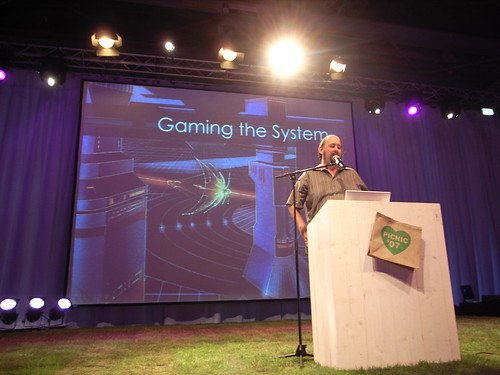(Cross-posted at Terra Nova) Science Mag has an article entitled "The Scientific Research Potential of Virtual Worlds" by William Sims Bainbridge which gives a pretty good overview of how games such as MMO have a "great potential as sites for research in the social, behavioral, and economic sciences, as well as in human-centered computer science.
Although the examples are well-known now, what is interesting in this article is the emphasis on the environment and methodological choices: which environment can be tight to what methodologies as described in the following excerpt:
"In terms of scientific research methodologies, one can do interviews and ethnographic research in both environments, but other methods would work better in one than the other. SL is especially well designed to mount formal experiments in social psychology or cognitive science, because the researcher can construct a facility comparable to a real-world laboratory and recruit research subjects. WoW may be better for nonintrusive statistical methodologies examining social networks and economic systems, because it naturally generates a vast trove of diverse but standardized data about social and economic interactions. Both allow users to create new software modules to extract data. (...) WoW is a very conducive environment for quantitative research because it encourages individuals to write "mod" or "add-on" programs, and scientists can use some existing software as research tools or write their own. These range all the way from very simple sequences of character behaviors constructed using macros built into the WoW user interface to long programs written in the Lua language. For example, one widely used program called Auctioneer analyzes prices on the WoW virtual item auction system, and CensusPlus tallies all the players currently online by several characteristics (...) Other fields of computer and information science that may use virtual worlds as laboratories include human/computer interaction (HCI), where "machinima" videos shot in virtual worlds may be used to develop prototypes of a wide range of systems and new methods of information visualization"
Although I am not a great fan of SL, it's very rare to see a discussion about the merits of certain platform to conduct X and Y type of research (also crossed with the disciplines). I'd be happy to know more about the use of other platforms; for example I've seen psychological studies about immersion using car games. What FPS and RTS can be useful for? What about mini-games? Is tangible interaction a good model for certain phenomena?
The article continues by addressing how different disciplines may find virtual worlds worthwhile to explore as research platforms (for example how political sciences may find the experimental method in small laboratory studies). The advantages the author points out ranges from the easiness to recruit participants, the availability of scripting and graphic tools, the motivation factor.
To some extent, the article has a great literature review of existing work (close to the Terra Nova community!) about this topic but I am a bit less optimistic than the author ("Virtual worlds may help unify some branches of the social sciences and give them greater scientific rigor. "). Anyhow, virtual environments at least emable people to talk about a common object and make comparisons.



 (A screen capture of Habbo Hotel as shown on the Gamasutra website)
(A screen capture of Habbo Hotel as shown on the Gamasutra website)





 (Picture is glitch in Second Life found
(Picture is glitch in Second Life found 


